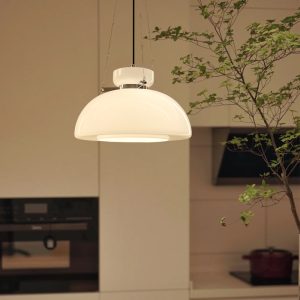
Shedding Light on Kitchen Design: Illuminating Your Space with the Perfect Kitchen Light
Proper lighting is an essential element in any kitchen design. It not only enhances the overall aesthetic appeal of the space but also plays a crucial role in improving safety, functionality, and ambiance. From providing adequate illumination for food preparation to creating a warm and inviting atmosphere for entertaining guests, the right top5lamp lighting can transform your kitchen into a functional and beautiful space. In this article, we will explore the importance of proper lighting in the kitchen and discuss various types of lighting, how to choose the right light fixtures, and tips for maximizing natural light. We will also delve into energy-efficient lighting solutions, using lighting to enhance your kitchen’s style, and maintenance and care for your kitchen lighting system.
The Importance of Proper Lighting in the Kitchen
Proper lighting in the kitchen is essential for several reasons. First and foremost, it improves safety by ensuring that you can see what you’re doing while working with sharp knives and hot appliances. Adequate task lighting is crucial for food preparation areas such as countertops and stovetops, where precision is required. Without proper lighting, there is an increased risk of accidents and injuries.
Functionality is another key aspect that proper lighting enhances in the kitchen. Different tasks require different levels of illumination, and having multiple layers of light can help create a well-lit workspace. For example, ambient lighting provides overall illumination for the entire space, while task lighting focuses on specific areas where detailed work is done. Accent lighting can be used to highlight certain features or objects in the kitchen, such as artwork or architectural elements. Betudesign
Lastly, proper lighting sets the mood and ambiance in the kitchen. Whether you’re hosting a dinner party or enjoying a quiet meal with your family, the right lighting can create a warm and inviting atmosphere. Dimmable lights are particularly useful in this regard as they allow you to adjust the brightness according to your needs and preferences.
Types of Kitchen Lighting to Consider
There are three main types of lighting to consider when designing your kitchen: ambient, task, and accent lighting.
Ambient lighting provides overall illumination for the entire space. It is typically achieved through ceiling-mounted fixtures such as recessed lights, flush mounts, or chandeliers. Ambient lighting should be bright enough to ensure that the entire kitchen is well-lit but not too harsh or glaring.
Task lighting focuses on specific areas where detailed work is done, such as countertops, stovetops, and sinks. Under-cabinet lights, pendant lights, and track lighting are commonly used for task lighting. These lights should be bright enough to provide adequate illumination for tasks but not so bright that they create shadows or glare.
Accent lighting is used to highlight specific areas or features in the kitchen, such as artwork, architectural elements, or decorative objects. This type of lighting adds depth and visual interest to the space. Examples of accent lighting include recessed lights with adjustable trims, wall sconces, and strip lights.
Choosing the Right Light Fixtures for Your Kitchen
When choosing light fixtures for your kitchen, there are several factors to consider. First and foremost, you need to determine the size of the fixtures based on the size of your kitchen. Large fixtures may overwhelm a small kitchen, while small fixtures may not provide enough illumination for a large kitchen.
Style is another important consideration. The light fixtures should complement the overall style and design of your kitchen. For example, if you have a modern kitchen with sleek and minimalist aesthetics, you may opt for simple and streamlined fixtures. On the other hand, if you have a traditional kitchen with ornate details, you may choose fixtures with more decorative elements.
Placement is also crucial when it comes to choosing light fixtures. Task lighting should be strategically placed above work areas such as countertops and stovetops to provide adequate illumination. Ambient lighting should be evenly distributed throughout the space to ensure that the entire kitchen is well-lit. Accent lighting should be placed to highlight specific areas or features in the kitchen.
Some examples of light fixtures that work well in the kitchen include pendant lights, which can be hung over an island or dining table to provide both task and ambient lighting. Under-cabinet lights are great for illuminating countertops and creating a well-lit workspace. Recessed lights are versatile and can be used for ambient, task, or accent lighting depending on their placement and trim options.
How to Create a Well-Lit Work Triangle in Your Kitchen
The work triangle is a concept used in kitchen design to create an efficient and functional workspace. It refers to the imaginary triangle formed by the three main work areas in the kitchen: the sink, the refrigerator, and the stove. Proper lighting is crucial in creating a well-lit work triangle.
To ensure that each area of the work triangle is well-lit, it is recommended to use a combination of ambient, task, and accent lighting. Ambient lighting should be evenly distributed throughout the kitchen to provide overall illumination. Task lighting should be focused on specific areas such as countertops, stovetops, and sinks to provide adequate illumination for detailed work. Accent lighting can be used to highlight certain features or objects within the work triangle, such as a decorative backsplash or a statement range hood.
It is important to note that the intensity of lighting within the work triangle may vary depending on personal preferences and needs. For example, some people may prefer brighter task lighting for precise cutting and chopping, while others may prefer softer lighting for a more relaxed ambiance.
The Role of Accent Lighting in Kitchen Design

Accent lighting plays a crucial role in kitchen design as it adds depth and visual interest to the space. It can be used to highlight specific areas or features in the kitchen, such as artwork, architectural elements, or decorative objects.
One way to use accent lighting in the kitchen is to install recessed lights with adjustable trims. These lights can be directed towards a specific area or object to create a focal point. For example, you can use recessed lights to highlight a beautiful backsplash or a collection of cookbooks on a shelf.
Another option is to use wall sconces to create a dramatic effect. Wall sconces can be installed above or beside a piece of artwork or architectural feature to draw attention to it. They can also be used to create a soft and warm glow in the kitchen.
Strip lights are another popular choice for accent lighting in the kitchen. They can be installed under cabinets, along the toe kick, or inside glass-front cabinets to create a subtle and elegant effect. Strip lights are particularly useful for highlighting glassware, china, or other decorative objects.
Maximizing Natural Light in Your Kitchen
Natural light is highly desirable in any kitchen as it not only enhances the overall aesthetic appeal but also provides numerous benefits. It can make the space feel larger, brighter, and more inviting. Additionally, natural light is energy-efficient and can help reduce electricity costs.
There are several ways to maximize natural light in your kitchen. First and foremost, consider the placement and size of windows. If possible, position windows strategically to allow for maximum sunlight penetration. Large windows or floor-to-ceiling windows are ideal for maximizing natural light.
Another way to maximize natural light is by using light-colored surfaces. Light-colored walls, cabinets, and countertops reflect more light and make the space feel brighter and more open. Avoid dark colors as they absorb light and can make the space feel smaller and gloomier.
Adding mirrors is another effective way to maximize natural light in the kitchen. Mirrors reflect light and create an illusion of more space. Consider placing a mirror opposite a window or on a wall adjacent to a window to bounce natural light around the room.
Tips for Lighting a Small Kitchen
Lighting a small kitchen can be challenging due to limited space. However, with the right techniques and fixtures, you can create a well-lit and visually appealing space.
One tip for lighting a small kitchen is to use recessed lighting. Recessed lights are installed flush with the ceiling, which helps save space and create a clean and streamlined look. They provide ambient lighting without taking up valuable headroom.
Another tip is to avoid bulky fixtures that can overwhelm the space. Instead, opt for slim and compact fixtures that blend seamlessly with the overall design of the kitchen. For example, pendant lights with a small footprint can provide both task and ambient lighting without taking up too much visual space.
Utilizing under-cabinet lights is another effective way to light up a small kitchen. These lights not only provide task lighting for countertops but also create a sense of depth and visual interest. LED strip lights are particularly popular for under-cabinet lighting as they are energy-efficient and produce minimal heat.
Energy-Efficient Lighting Solutions for Your Kitchen
Energy-efficient lighting is not only environmentally friendly but also cost-effective in the long run. There are several energy-efficient lighting solutions available for your kitchen.
LED bulbs are one of the most popular energy-efficient options. They consume significantly less energy than traditional incandescent bulbs and have a longer lifespan. LED bulbs are available in various color temperatures, allowing you to choose between warm or cool lighting depending on your preferences.
Motion sensors are another energy-efficient option for your kitchen. These sensors detect movement and automatically turn on or off the lights accordingly. They are particularly useful in areas such as pantries or closets where lights may be left on unintentionally.
Dimmer switches are also worth considering for energy efficiency. They allow you to adjust the brightness of your lights according to your needs and preferences, reducing energy consumption when full brightness is not required.
How to Use Lighting to Enhance Your Kitchen’s Style
Lighting can be used to enhance the style and design of your kitchen, creating different moods and atmospheres. The type of lighting you choose can greatly impact the overall aesthetic appeal of the space.
For a modern and minimalist kitchen, consider using sleek and streamlined fixtures such as recessed lights or pendant lights with clean lines. These fixtures will complement the clean and simple design of the space.
If you have a traditional or farmhouse-style kitchen, consider using fixtures with more decorative elements such as chandeliers or lantern-style pendant lights. These fixtures will add a touch of elegance and charm to the space.
To create a cozy and intimate atmosphere, consider using warm and soft lighting. This can be achieved through the use of dimmable lights or warm-colored bulbs. Pendant lights with fabric shades or wall sconces with frosted glass can also create a soft and diffused glow.
On the other hand, if you want to create a bright and vibrant atmosphere, consider using cool-colored bulbs or fixtures with exposed bulbs. This will create a more energetic and lively ambiance in the kitchen.
Maintenance and Care for Your Kitchen Lighting System
Proper maintenance and care are essential for ensuring that your kitchen lighting system functions optimally and lasts for a long time. Here are some tips for cleaning and maintaining your light fixtures:
– Regularly dust your light fixtures to prevent dust buildup, which can reduce their brightness.
– Clean glass shades or covers with a mild detergent or glass cleaner to remove dirt and smudges.
– Replace burnt-out bulbs promptly to maintain adequate illumination.
– Check electrical connections periodically to ensure that they are secure and free from corrosion.
– If you have recessed lights, make sure they are properly insulated to prevent heat loss or gain.
– Consider scheduling regular professional inspections to identify any potential issues or safety hazards.
By following these maintenance and care tips, you can prolong the lifespan of your kitchen lighting system and ensure that it continues to provide optimal illumination.
Proper lighting is a crucial element in any kitchen design. It improves safety, functionality, and ambiance while enhancing the overall aesthetic appeal of the space. By considering the different types of lighting, choosing the right light fixtures, and maximizing natural light, you can create a well-lit and visually appealing kitchen. Additionally, energy-efficient lighting solutions can help reduce electricity costs and minimize environmental impact. By using lighting to enhance your kitchen’s style and properly maintaining your lighting system, you can create a functional and beautiful space that you will enjoy for years to come.


